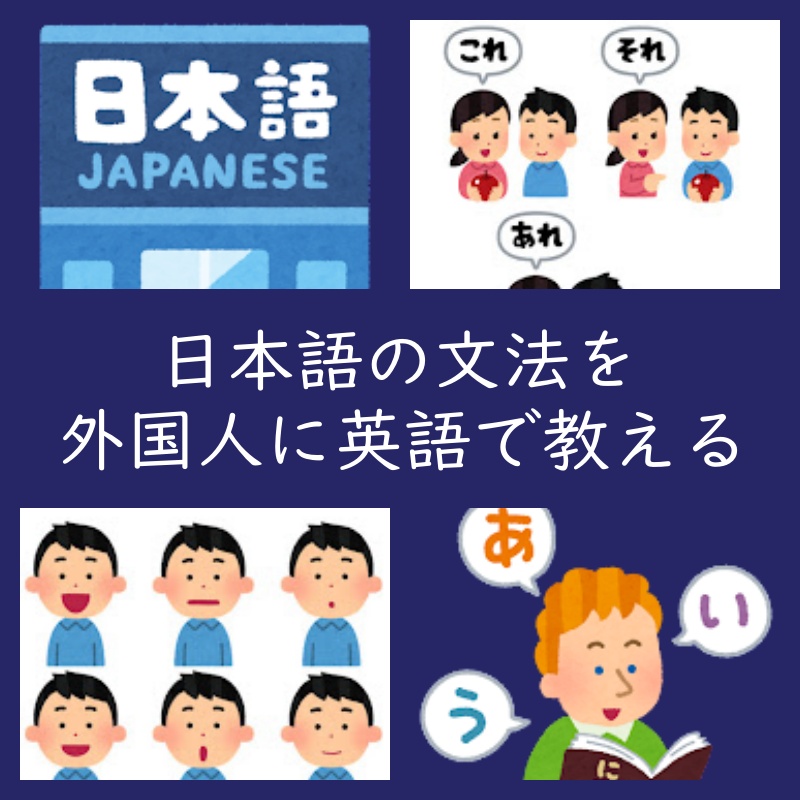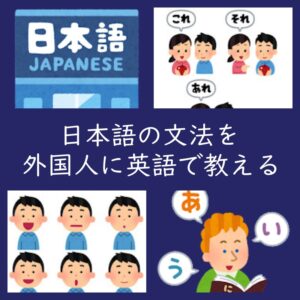ページをシェアしながら外国人に日本語の文法を教えたいと思ったのが、この記事を作った動機です。Sharing the page, I wanted to teach Japanese grammar to foreigners, which was my reason for creating this article.
この記事の中では日本語の文法を順を追って説明しています。Japanese grammar is explained step by step in this article.
日本語の文法に焦点を当てたかった為、単語そのものの解説は省きました。単語は別で練習してください。Because I wanted to focus on Japanese grammar, I omitted explanations of the words themselves. Please practice the words separately.
またこの記事そのものは文法の解説を詳細に行うものではありません。日本語を教える立場の人は内容を理解できると思うので、口頭で説明してあげると良いと思います。Also, this article itself is not intended to be a detailed explanation of grammar. Those who are in a position to teach Japanese will be able to understand the content, and it would be good to explain it orally.

Lesson1 : XのY
「の」は2つの名詞を繋ぐ助詞です。
「の」is a particle linking two nouns.
<<れい(example)>>
- わたし の なまえ (my name)
- あなた の しごと (your job)
- フィリピン の しゅと (Capital of the Philippines)
- となり の トトロ (My Neighbor Totoro)
- はちみつ の あじ (a taste of honey)
<<れんしゅう(exercise)>>
XのYを作ってみよう。
| X | Y | |
| 1 | わたし | ほん book |
| 2 | そら sky | いろ color |
| 3 | くるま car | はやさ speed |
| 4 | みんな everybody | もの property, stuff |
| 5 | おかあさん mother | たんじょうび birth day |
| 6 | きのう yesterday | てんき weather |
例を作ってみましょう!
Enjoy making an example!
Lesson2 : AはBです。
これ、あれ、それ
- これはBです。This is B.
- あれはBです。That is B.
- それはBです。It is B.
<<れい(Example)>>
- これは くるま です
- あれは わたしのほんです。
- それは みんなのもの です。
<<れんしゅう(Exercise)>>
AとBに言葉を入れて文を作ってみよう
| A | B | |
| 1 | これ | とけい clock |
| 2 | あれ | さいふ wallet |
| 3 | それ | でんわばんごう
telephone number |
| 4 | あれ | トイレ toilet |
| 5 | それ | バス bus |
文を作ってみましょう!
Let’s make a sentence!
ちゅうい!Notes!
日本で人を紹介する時に「これは私の友達です」とは言いません。たとえば「彼女は私の友達です」と言いましょう。
When introducing someone in Japan, you do not say, 「これ は わたしのともだち です」. For instance, Say「かのじょ は わたし の じょうし です。」
A=B
AはBです。A is B.
<<れい(Example)>>
A : わたし/B : ジェリー Gelly
わたし は ジェリー です。
A : かれ he/B : がくせい student
かれ は がくせい です。
A : せんこう major/B : にほんご
せんこう は にほんご です。
<<れんしゅう(Exercise)>>
| A | B | |
| 1 | わたし | フィリピンじん |
| 2 | かのじょ
she |
りゅうがくせい
overseas student |
| 3 | わたし の せんこう
My major |
きょういく
education |
| 4 | かれ
he |
30さい
30years old |
| 5 | かれら
they |
2 ねんせい
second grade |
\英語で日本語を学べる定番テキスト/
Lesson3 : AはBですか?
はい/いいえ の しつもん
ぎもんぶんに するためには「か」をつけます。
AはBです。A is B.
AはBですか。Is A B?
<<れい(Example)>>
A : あなた/B : ジェリーさん Gelly
あなた は ジェリーさん ですか。
A : かれ he/B : がくせい student
かれ は がくせい ですか。
A : せんこう major/B : にほんご
せんこう は にほんご ですか。
<<れんしゅう(Exercise)>>
| A | B | |
| 1 | あなた | にほんじん |
| 2 | かのじょ
She |
あなた の いもうと
your sister |
| 3 | きょうのてんき | はれ |
| 4 | はなのいろ
colour of a flower |
しろ
white |
| 5 | あなたのむすこさん
your son |
こうこうせい
high school student |
自分で文を作ってみよう!
Make your own sentences!
5Wのしつもん
おぼえましょう!
- いつ when
- どこ where
- だれ who
- どれ which
- なに/なん what
これらを使って「AはBですか」の文を作ります。
<<れいぶん(Example)>>
しつもんの文 question sentences
- あなた の たんじょうび は いつですか?
- とうきょうえき は どこ ですか?
- きょうのせんせい は だれですか?
- あなた の かさ は どれですか?
- それは なん ですか?
こたえの文 Answer sentences
- 12がつ18にち です。
- しんばしえき の つぎ です。Next to Shimbashi station.
- すずき せんせい です。
- これ です。
- フィリピンのジプニー です。
<<れんしゅう(Exercise)>>
AはBですか。
| A | B | |
| 1 | つぎのレッスン
next lesson |
いつ |
| 2 | しゅっしん
hometown |
どこ |
| 3 | あの がくせい
that student |
だれ |
| 4 | あなたの くつ
your shoes |
どれ |
| 5 | これ | なん |
自分で文を作ってみよう!
Make your own sentences!
Whatのしつもん
およぼえましょう!
- なん what
- なんじ what time
- なんがつ what month
- なんようび what day
- なん さい what age(how old)
この他にもたくさんの なん what を使った質問が出来ますね。「なんばん what number」「なんキロ how many kilograms」「なんメートル How many meters」などなど。
これらを使って「AはBですか」の文を作ります。
<<れいぶん(Example)>>
しつもんの ぶん question sentences
- あなた の せんこう は なんですか。
- いまは なんじ ですか。
- うんどうかい は なんがつ ですか。
- あした は なんようび ですか。
- あなた は なんさい ですか。
こたえの ぶん Answer sentences
- れきし です。It is history.
- 5じ19ふんです。
- ことしは 5月です。It is May this year.
- にちようび です。
- 24さい です。
<<れんしゅう(Exercise)>>
AはBですか。
| A | B | |
| 1 | あなた の おしごと
Your occupation |
なん |
| 2 | あなた の でんわばんごう
Your phone number |
なんばん |
| 3 | きおん
air temperature |
なんど |
| 4 | あなた の ねこ | なんびき |
| 5 | あなた の いもうと の なまえ
Your sister’s name |
なん |
自分で文を作ってみよう!
Make your own sentences!
Lesson4 : Noun じゃないです。
「AはBです。A is B.」を否定する際には、「AはBじゃないです。A is not B」と表現します。To negate “AはBです。”, you can use the phrase “AはBじゃないです。”.
<<れいぶん(Example)>>
Q: あなたは いしゃ ですか?Are you a doctor?
A1: いいえ。わたし は いしゃ じゃないです。
A3: いいえ。わたし は いしゃ じゃありません。
A3: いいえ。わたし は いしゃ ではありません。
<<れんしゅう(Exercise)>>
Q: AはBですか?
A: いいえ。Bじゃないです。Cです。
| A | B | C | |
| 1 | あなた | かいしゃいん
office worker |
いしゃ
doctor |
| 2 | かれ
he |
おにいさん
older brother |
おとうさん
father |
| 3 | あなたのペット
your pet |
いぬ
dog |
ねこ
cat |
| 4 | これ | おちゃ
green tea |
おさけ
sake |
| 5 | あなたの
しゅっしん |
かんこく
korea |
にほん |
Lesson5 : Whoseのしつもん
だれの持ち物かを質問するときは「だれの」を使います。
Use 「だれの」 when asking a question about who owns something.
おぼえましょう!
Q : これは だれの じてんしゃ ですか?Whose bicycle is this?
A1 : それは おとうと の じてんしゃ です。It is my brother’s bicycle.
A2 : それは おとうと の もの です。It is my brother’s one.
<<れんしゅう(Exercise)>>
Q : AはだれのBですか?Whose B is A?
A : それはCのものです。It is C’s one.
| A | B | C | |
| 1 | これ | おかね | わたし |
| 2 | あれ | ぼうし hat | せんせい |
| 3 | それ | くるま car | おとうさん |
| 4 | これ | めがね glasses | わたし の おとうさん |
| 5 | あれ | かめら camera | ケイト の おかあさん |
Lesson6 : この、あの、その、どの+Noun
おぼえましょう!
- この ペン (This pen)
- あの スマホ (that smartphone, over there)
- その じてんしゃ (that bicycle)
- どの くに (which country)
<<れいぶん(Example)>>
- この Tシャツ は いくら ですか。How much is T-shirt.
- あのノート は わたしのもの です。That notebook is mine.
- そのしんぶん は 100えん です。The newspaper is 100 yen.
- どのひと が あなたのおとうさん ですか?Which one is your father?
<<れんしゅう(Exercise)>>
にほんご で いってみよう!
- How much is this watch?
- That vegetable over there is delicious.
- That onion is 80 yen.
- Which book is English book?
こたえ
- この とけい は いくら ですか。
- あの やさい は おいしい(です)。
- その たまねぎ は 80えん です。
- どの ほん が えいごのほん ですか。
Lesson7:ここ、そこ、あそこ、どこ
We will learn one more ko-so-a-do set for place.
ここ here, near me
そこ there, near you
あそこ over there
どこ where
<<れいぶん(Example)>>
- ここは オフィスです。Here is the office.
- こうばんは あそこです。The police box is over there.
- そこにあるのは、なんですか。What is that there?
- トイレは どこですか。Where is the toilet?
Lesson8 : Noun +も (too, also)
他のことと同様にこのことが成立するというときに「名詞+も」を使います。
Use “noun + も” to say that other things are the same as this thing, meaning 「also」「too」。
<<れいぶん(Example)>>
- アンディさんは がくせい です。Andy is a student.
- ああ、そうですか。わたし も がくせい です。Oh, I see. I am a student too.
<<れんしゅう(Exercise)>>
AはBです。A is B.
CもBです。C is also B.
| A | B | C | |
| 1 | わたし | かいしゃいん
office worker |
かれ
he |
| 2 | かのじょ | えいごのせんせい
English Teacher |
わたし |
| 3 | たなか さん | いしゃ
doctor |
すずき さん |
| 4 | この ほん | 500えん | あの ほん |
| 5 | この Tシャツ | あか red | この ぼうし |
「も」を使って文を作ってみよう。
Let’s make a sentence using 「も」.
Lesson9 : ~ね /~よね/~よ
「~ね」「~よね」「~よ」are sentence-ending particles.
1.~ね
相手の注意を引いたり、相手がちゃんと聞いている確認するときにつかう。Use it to get the other person’s attention or to confirm that the other person is listening.
<<れいぶん(Example)>>
- かのじょ は えいごのせんせい ですね。She is an English teacher, right?
- あなた は ねこ が すきですね。You like cats, correct?
2.~よね
確認したり、同意を求める時に使う表現。「~ね」より強い。An expression used to confirm or ask for agreement. It is stronger than 「~ね」.
- あした の てんき は あめ ですよね。Tomorrow’s weather is rainy, right?
- これは さかな じゃない ですよね。This is not a fish, is it?
3.~よ
自分の意見を相手に投げつけ、軽く誘ったり忠告したり、注意を引く時などに使う言い回しです。It is a phrase used to throw one’s opinion at the other person and lightly invite, advise, or draw attention to it.
- このほん は 1000えん ですよ。This book is 1,000 yen.
- わたし の しゅっしん は かんこく じゃないですよ。I am not from Korea.
\英語で日本語を学べる定番テキスト/
=スポンサーリンク=
まとめ Summary
順次追加していきます。
たのしく にほんご を まなびましょう!



コメントお願いします(※は必須項目)